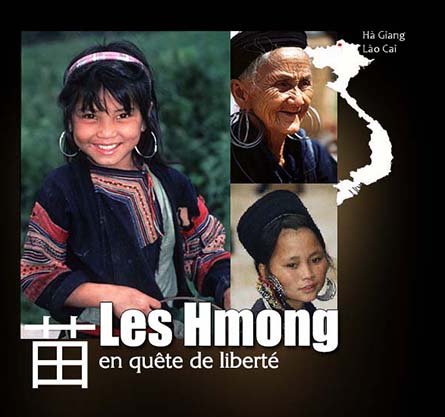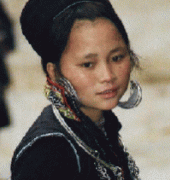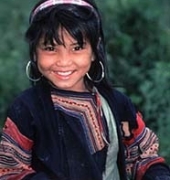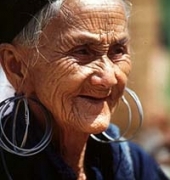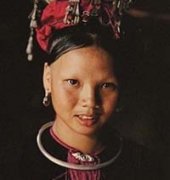The Hmong are divided into local sub-groups: the Green Hmong, the Red Hmong, the variegated Hmong, the Black Hmong and the Na Mieo.
The Hmong (The Miao or Miêu in vietnamese) actually living in Vietnam are descendants of emigrants from South China. Around the end of 18th century and the beginning of 19th century, the Hmong emigrated to Indochina peninsula (Laos, Vietnam and Thaïland) and settled away from plains already occupied by majority ethnic group in mountainous areas of Hà Giang and Lào Cai provinces.
Their migration story was closely related to the insubordination to the Chinese culture and the policy of asssimilation practiced by northerners. According to mythic tales passed down from generation to generation, their ancestors lived in snow and ice covered regions where the night lasted almost 6 months. That is why, being accustomed to living in tropical regions and not having the opportunity to see the snow, the Hmong use terms such as « nước cứng » (or solid water) and « cát trắng mịnh » (or fine white sand) to designate respectively the ice and the snow. According to historians, their origin would be in Siberia (Tây Bá Lợi Á) and in vast plateaus of Mongolia. Some Caucasian proeminent traits are detected among the Hmong today. Others preferably opt for Tibet because shamanic rituals. One has speculations more than certainties about the accuracy of the Hmong geographic origin. In the Chinese writings, the Hmong were designated under the Miao name including initially all the ethnic peoples non han living in South West China. Today, this name is reserved to the population group specifically identified and distinct gathering together the Hmong living in Indochina peninsula and the Miao ethnic minority populations (The Hmong, the Hmou, the Qoxiong and the Hmau) closely related at the linguistic and cultural level in China.
Originally related to the drawing of rice field (Điền) above which is added the pictogram Thảo” (cỏ) (herb)(key 140), the Chinese character Miao (or Miêu in vietnamese) clearly shows the way that the Chinese adopt to call the people knowing the rice cultivation with their language. Being initially rice farmers, the Miao had the sedentary lifestyle in plains. As the Miao were chased by successive waves of the Chinese who dispossessed them of their arable land and their rice field, they were forced to become highlanders and stayed until today. Being rushed to high altitudes in inaccessible and hostile mountain areas, they were forced to adapt themselves to each environment where they looked for an agricultural model allowing them to practice the rice cultivation (rice terraces). In spite of that, the Chinese had the habit of traiting them as the barbarians. The Chinese have gone as far as making a distinction between the shu Miao ( or the cooked Hmong) and the sheng Miao (the uncooked Hmong), that means the assimilated Hmong and the diehard Hmong on the margins of Chinese civilization. They had the task of transforming these sheng Miao into shu Miao. Myths and facts are not miss to enrich the history of the Miao (or the Hmong). The latter is punctuated by endless conflicts with the Chinese since time immemorial. This long history of resistance to oppression gives them a particular reputation: they cannot be assimilated and very belligerent.
A people in search of freedom
The Miao ( or the Hmong ) lived together with Hsia(1) tribes since prehistoric times in the middle of Yellow River Basin (Honan or Hà Nam in vietnamese). Being associated with Chi You ( Suy Vưu ), they engaged the first confrontation leading to failure with the death of the latter at Zhuolu (Trác Lộc) in Heibei province (Hồ Bắc) (approximatively 2690 before J.C.).They were henceforth repelled by Yellow emperor Huang Yuan (Hiên Viên) and Yu the Great (Ðại Vũ) in the Bai Yue territory at the Yang Tsé Basin River. Other conflicts were evoked with Miao groups in Chinese historical writings of Shan and Zhou dynasties (1121 – 256 before J.C.). In the middle course of Yang Tsé River (Dương Tữ Giang), they exercised significant influence over the political and social life of the Chu kingdom (Sỡ Quốc). The latter was considered as one of three principalities fighting among themselves for supremacy during the Warring States period (Thời Chiến Quốc). In addition to the soul recalling, we noted the close ties between the Chu culture and the Miao on the various cultural traits (lifestyle, habitat, language etc…)(2). They constituted probably the force majeure in the Chu population with the Luo Yue (the Proto-Vietnamese) and the ancestors of Thaï today (The Si Ngeou or Tây Âu). This force majeure became the first bulwark of Yue and Miao tribes in the committed fight against the Chinese.
Pictures of Hmong women
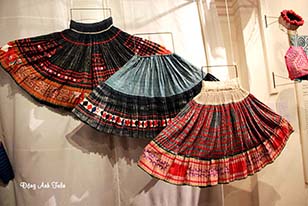
Being in hemp, silk or cotton, the Hmong pleated skirt whose decoration is own to every group, requires more than 20 meters for the length of the fabric. The method of pleating is one of the characteristics of Hmong women skirt.
© Đặng Anh Tuấn
After the disappearance of this kingdom, the Miao continuated to be repelled in Guizhou (Quí Châu), Sichuan and Yunnan mountains. Other military conflicts had emerged with Miao groups in the era of the first dynasty of the Han (140 – 87 before J.C.) and during Five Dynasties (140 – 87 before J.C.). The Miao name was forgotten temporarily in Chinese writings until the establishment of Chinese suzerainty on these provinces by the Yuan ( or the Mongols of China). Then it was regularly mentionned again under the Ming dynasty. Because the Chinese strong demographic growth ( from 100 millions to 450 millions between 13th and 18th centuries), the Chinese of the Ming dynasty continued to deprive the Hmong of their plateaus and their rice fields, which caused simultaneously the exodus and the fight engaged by the Hmong in the defense of their land. Some Hmong took up arms. Other preferred to seek refuge in Indochina pensula, in particular in Vietnam by three successive waves of which the most important was maked by the Taiping mystical insurrection known under the name of Tai Ping Tian Guo (Thái Bình Thiên Quốc) against the Qing (from 1840 to 1868). The Hmong thus became a minority ethnic group of Vietnam since three centuries.
(1): There is the ancient name given to the Chinese.
(2): First symposium on the history of Chu kingdom (Jingzhu, Hubei, december 1981).

